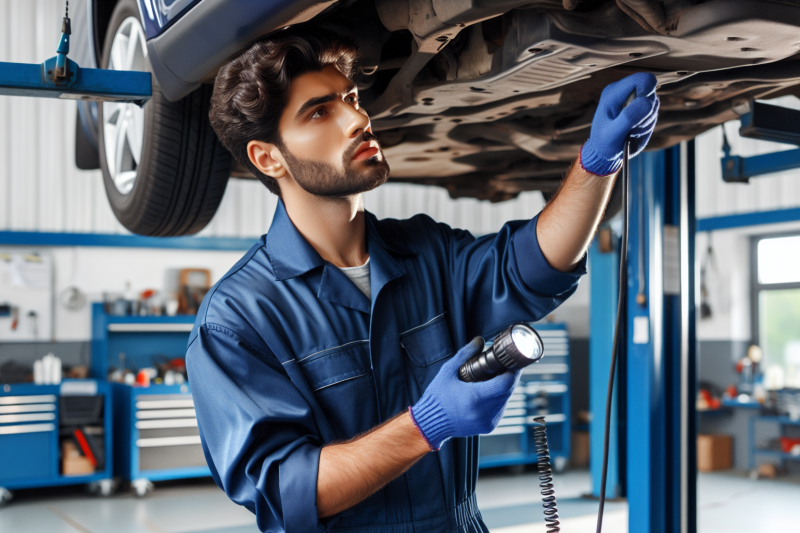
Table Of Contents
Table of Contents
- 1 Table Of Contents
- 2 Introduction
- 3 Spring Car Maintenance
- 4 Summer Car Maintenance
- 5 Fall Car Maintenance
- 6 Winter Car Maintenance
- 7 Conclusion
- 8 FAQ
- 8.1 What are some basic year-round car maintenance tips?
- 8.2 How often should tires be checked?
- 8.3 Why is it essential to change the oil regularly?
- 8.4 What should be done for winter car maintenance?
- 8.5 How can summer heat affect a car?
- 8.6 Is it necessary to inspect the brakes seasonally?
- 8.7 What fluids should be regularly checked?
- 8.8 How often should the air filter be replaced?
- Introduction
- Spring Car Maintenance
- Summer Car Maintenance
- Fall Car Maintenance
- Winter Car Maintenance
- Conclusion
- FAQ
Introduction
Seasonal car maintenance ensures that vehicles perform optimally year-round. Different weather conditions impose various demands on car components. By adhering to a season-specific maintenance schedule, car owners can avoid unexpected breakdowns, enhance safety, and extend the lifespan of their vehicles.
Importance of Seasonal Car Maintenance
Seasonal car maintenance is crucial for several reasons. Weather extremes, be it intense heat or severe cold, can significantly impact a vehicle’s performance. Regular upkeep tailored to the season prepares cars to handle these conditions efficiently.
For instance, cold temperatures can make engine oil thicker, hampering its flow, while heat can cause engine coolant to evaporate more quickly. Addressing these seasonal issues can prevent potential damage and expensive repairs.
Overview of Key Maintenance Tasks
- Spring: Inspect the tires for uneven wear and rotate them if necessary. Check the wiper blades and replace them if they appear worn out. Clean the undercarriage to remove any remaining salt from winter. Ensure the air conditioning system is functioning properly.
- Summer: Test the battery, as extreme heat can reduce its lifespan. Verify the coolant level and top it up if needed. Ensure tires are correctly inflated, as heat can increase the risk of blowouts. Examine the brake system thoroughly.
- Fall: Top off all fluids including antifreeze, washer fluid, and brake fluid. Inspect the tires and consider switching to winter tires if necessary. Check the heater and defroster systems to ensure they are working well.
- Winter: Maintain tire pressure, as cold air can cause it to drop. Use winter-grade oil for easier engine starts. Keep the gas tank at least half full to prevent fuel lines from freezing. Carry an emergency kit with essentials like a blanket, flashlight, and ice scraper.
By following these season-specific maintenance tasks, car owners can reduce the likelihood of breakdowns and ensure their vehicles are ready for the challenges each season presents.
Spring Car Maintenance
Inspecting Tires and Brakes
Drivers should examine their tires for any signs of wear and tear, such as uneven tread or bald spots. Checking tire pressure is crucial, as temperature changes in spring can cause fluctuations. Ensuring all tires are properly inflated enhances safety and fuel efficiency.
Brakes should be inspected for wear on brake pads and rotors. Brake fluid levels need checking to ensure the brakes function optimally. If any squeaking or grinding sounds occur, it may indicate the need for brake maintenance or replacement.
Checking Fluid Levels
Vehicle owners must check all essential fluid levels including engine oil, coolant, brake fluid, transmission fluid, and windshield wiper fluid. Fresh engine oil prevents engine wear and tear. The coolant level should be adequate to avoid overheating as temperatures rise.
Brake and transmission fluids play key roles in vehicle performance and safety. Replenishing windshield wiper fluid ensures clear visibility during spring rains.
Cleaning and Detailing
Spring cleaning and detailing the car are vital for maintaining its appearance and performance. Salt and grime from winter roads can accumulate on the vehicle’s exterior, causing potential damage. A thorough wash, including the undercarriage, removes these residues.
Interior detailing involves vacuuming to remove dirt and debris. Cleaning and conditioning leather or fabric seats maintain their longevity and appearance. Replacing cabin air filters improves air quality inside the car.
Battery Health Check
Inspecting the car battery is essential, as winter conditions can strain it. Checking the battery terminals for corrosion and ensuring they are tightly connected is vital. Clean terminals if necessary.
Testing the battery’s charge ensures it has sufficient power for spring and summer driving. If the battery is weak or more than three years old, considering a replacement can prevent unexpected breakdowns.
For comprehensive advice on spring car maintenance, this source provides valuable insights.
Summer Car Maintenance
Cooling System Check
Proper cooling system maintenance is crucial during summer. He should regularly inspect the coolant level and top it up if necessary. They must also check the radiator and hoses for any signs of leaks. Overheating can cause severe engine damage, so ensuring efficient cooling is essential.
Air Conditioning Performance
To maintain a comfortable interior temperature, it is important to ensure the air conditioning system is working optimally. He should have the refrigerant levels checked and refilled if necessary. It is also wise to clean or replace the cabin air filter for better air quality. If the A/C system isn’t cooling effectively, professional inspection might be required.
Tire Pressure and Condition
Tires can expand due to high temperatures, affecting performance and safety. They should regularly check the tire pressure, ideally once a month, to maintain the recommended levels. It is equally important to inspect the tires for wear and damage, including the spare tire. Properly inflated tires increase fuel efficiency and ensure safer handling.
Wiper Blades and Windshield Fluid
Even during summer, sudden rain showers can occur. He should examine the wiper blades for any signs of cracks or tears. Replacing worn-out blades will ensure clear visibility in wet conditions. Additionally, it is crucial to check and fill the windshield washer fluid reservoir to remove grime and bugs from the windshield effectively.
These maintenance steps are essential for keeping the car in good shape during the hot summer months. Proper attention to these details ensures safety and reliability on the road. More detailed information and tips can be found on resources like The Zebra.
Fall Car Maintenance
Inspecting Heater and Defroster
As temperatures drop, ensuring the heater and defroster are functioning properly becomes crucial. Heaters keep the car warm, while defrosters prevent fog and frost from impairing visibility. Conduct a thorough inspection by turning on the heater and defroster. Pay attention to any unusual smells or insufficient airflow. Consult a professional if any issues are noted.
Checking All Lights
Shorter days mean increased reliance on vehicle lights. Checking all lights—headlights, tail lights, brake lights, and turn signals—is essential. Replace any burned-out bulbs. Clean lenses to ensure maximum brightness. Properly functioning lights are crucial for safety during fall and winter months.
Changing Oil and Filter
Regular oil changes prolong engine life. Fall is a good time to change the oil and filter. Cold weather can thicken oil, making it less effective. Use oils suited for lower temperatures. Check the vehicle’s manual for recommended oil types.
Preparing Tires for Cold Weather
Inspecting tire tread depth is vital for safe driving on slippery roads. Tread depth should be at least 2/32 inches; deeper is preferable. Consider switching to winter tires if living in an area with heavy snowfall. Check tire pressure, as it drops with falling temperatures. Maintain the manufacturer’s recommended tire pressure for optimal performance.
For more detailed car maintenance tips, click here.
Winter Car Maintenance
Battery and Electrical System
The battery and electrical system are crucial during winter. Cold temperatures can decrease battery capacity, making it harder for the car to start. Regularly check the battery’s charge and clean any corrosion from the terminals. Ensure the electrical system, including lights and signals, is functioning properly. Replace weak or old batteries to prevent sudden failures.
Winter Tires Installation
Winter tires are essential for safe driving. They provide better traction on snow and ice compared to all-season tires. Install winter tires before the first snowfall. Check the tire pressure frequently as it can drop with the temperature. Ensure the tires have sufficient tread depth for optimal performance.
Using the Right Fluids
Fluids play a vital role in vehicle performance during winter. Use winter-grade oil as it flows better in cold temperatures. Check and top up the antifreeze to protect the engine from freezing. Ensure the windshield washer fluid is rated for low temperatures to prevent it from freezing. Regularly check the levels and quality of these fluids.
Emergency Kit Preparation
Prepare an emergency kit to stay safe in case of breakdowns. Include items such as:
- Warm blankets
- Extra clothing
- First aid kit
- Non-perishable food and water
- Flashlight with extra batteries
- Jumper cables
- Ice scraper and snow shovel
- Sand or kitty litter for traction
Having these items readily available can be invaluable during unexpected winter emergencies.
For more detailed winter car maintenance tips, visit Progressive.
Conclusion
Summary of Seasonal Maintenance Tips
Every season presents unique challenges and requirements for vehicle maintenance. In winter, it is crucial to check antifreeze levels and tire pressures. Spring maintenance includes inspecting wiper blades and cleaning the undercarriage. Summer requires checking the air conditioning system and battery health due to increased temperatures. In autumn, focus on inspecting brakes, lights, and ensuring the vehicle is ready for colder months.
Benefits of Regular Car Maintenance
Regular car maintenance extends the life of the vehicle. It helps in improving fuel efficiency, ensuring safety by preventing potential breakdowns, and maintaining the car’s value. Well-maintained cars have smoother operations and reduced risks of expensive repairs.
Final Thoughts and Recommendations
Adhering to seasonal maintenance schedules promotes the overall performance and safety of the vehicle. It is recommended to follow the car manufacturer’s maintenance guide and consult professionals for any complex tasks. For more comprehensive insights, visit our source.
FAQ
What are some basic year-round car maintenance tips?
Regular oil changes, tire rotations, and brake inspections. Check fluid levels such as coolant, transmission fluid, and windshield washer fluid. Inspect and replace wiper blades as needed. Keep the car clean to prevent rust and damage.
How often should tires be checked?
Tires should be checked monthly for proper inflation and wear. Utilize a tire gauge to check pressure. Refer to the owner’s manual for the correct pressure levels. Rotate tires every 6,000 to 8,000 miles to ensure even wear.
Why is it essential to change the oil regularly?
Regular oil changes keep the engine running smoothly and efficiently. They remove dirt and debris that can accumulate and cause engine damage. Follow the manufacturer’s recommendation for oil change intervals.
What should be done for winter car maintenance?
Check the battery and ensure it’s fully charged. Use winter-grade oil if specified. Inspect the heating system. Keep the gas tank at least half full to prevent fuel line freeze. Switch to winter tires for better traction.
How can summer heat affect a car?
Summer heat can cause battery fluid to evaporate, leading to a weakened battery. Overheating engines are more common in high temperatures. Check the coolant system and ensure the air conditioning is functioning correctly.
Is it necessary to inspect the brakes seasonally?
Yes, brakes should be inspected seasonally. They are critical for safety. Look for signs of wear and tear, such as squeaking or grinding noises. Replace brake pads and fluid as needed.
What fluids should be regularly checked?
Engine oil, coolant, transmission fluid, brake fluid, power steering fluid, and windshield washer fluid. Regular checks and top-ups can prevent many mechanical issues.
How often should the air filter be replaced?
The air filter should typically be replaced every 12,000 to 15,000 miles. A clogged filter can reduce engine efficiency and affect fuel economy.

